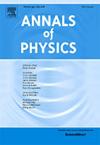Efficient recyclable generation protocol for high-dimensional spatial-path GHZ states
IF 3
3区 物理与天体物理
Q2 PHYSICS, MULTIDISCIPLINARY
引用次数: 0
Abstract
Multipartite high-dimensional entanglement offers a larger space for storing and processing quantum information and is the crucial resource in future high-capacity and high-security quantum networks. The high-efficiency generation of multipartite high-dimensional entanglement is of central importance for its application. In the paper, we propose a recyclable generation protocol for the four-photon three-dimensional spatial-path Greenberger–Horne–Zeilinger (GHZ) state with linear optical elements and practical “on-off” photon detectors. Our protocol is feasible under current experimental conditions, and the generated three-dimensional GHZ state can be preserved for applications. When the generation protocol fails, the output state may evolve into the auxiliary state for the next generation round. In this way, our protocol can effectively save precious EPR resources. With the increase of repeating number, our protocol will have a prominent advantage in saving precious entanglement resources. Our protocol can provide effective guidance for the experimental preparation of the three-dimensional spatial-path GHZ state, and has important application in future multipartite high-dimensional quantum networks.
高维空间路径GHZ态的高效可回收生成协议
多部高维纠缠为量子信息的存储和处理提供了更大的空间,是未来高容量、高安全量子网络的关键资源。多部高维纠缠的高效生成对其应用至关重要。在本文中,我们提出了一种可回收的四光子三维空间路径格林伯格-霍恩-塞林格(GHZ)态生成协议,该协议使用线性光学元件和实用的“开关”光子探测器。该方案在现有实验条件下是可行的,并且生成的三维GHZ态可以保留在实际应用中。当生成协议失败时,输出状态可能演变为下一轮的辅助状态。这样,我们的协议可以有效地节省宝贵的EPR资源。随着重复次数的增加,我们的协议在节省宝贵的纠缠资源方面将具有突出的优势。该协议可为三维空间路径GHZ态的实验制备提供有效的指导,在未来的多方位高维量子网络中具有重要的应用价值。
本文章由计算机程序翻译,如有差异,请以英文原文为准。
求助全文
约1分钟内获得全文
求助全文
来源期刊

Annals of Physics
物理-物理:综合
CiteScore
5.30
自引率
3.30%
发文量
211
审稿时长
47 days
期刊介绍:
Annals of Physics presents original work in all areas of basic theoretic physics research. Ideas are developed and fully explored, and thorough treatment is given to first principles and ultimate applications. Annals of Physics emphasizes clarity and intelligibility in the articles it publishes, thus making them as accessible as possible. Readers familiar with recent developments in the field are provided with sufficient detail and background to follow the arguments and understand their significance.
The Editors of the journal cover all fields of theoretical physics. Articles published in the journal are typically longer than 20 pages.
 求助内容:
求助内容: 应助结果提醒方式:
应助结果提醒方式:


